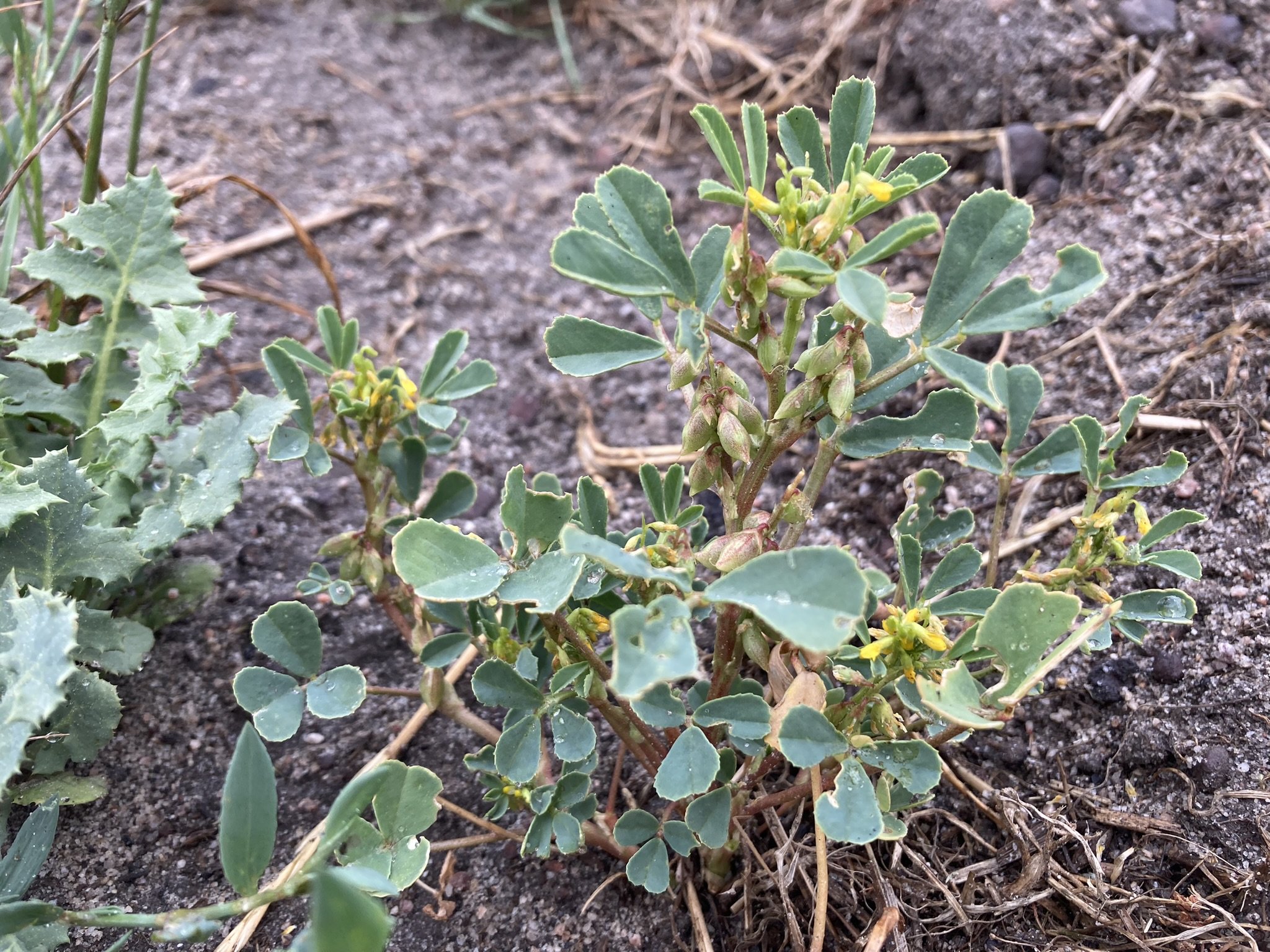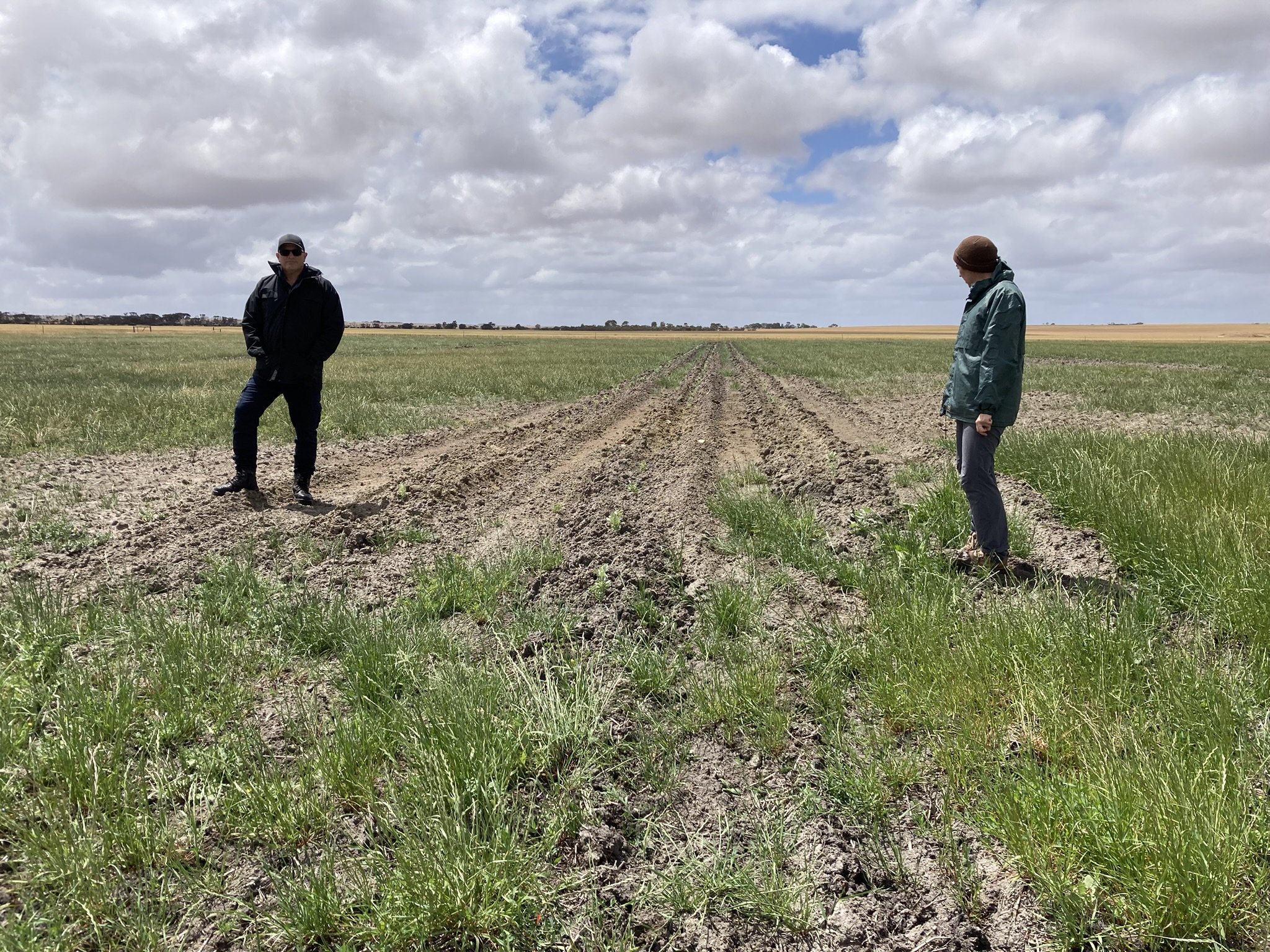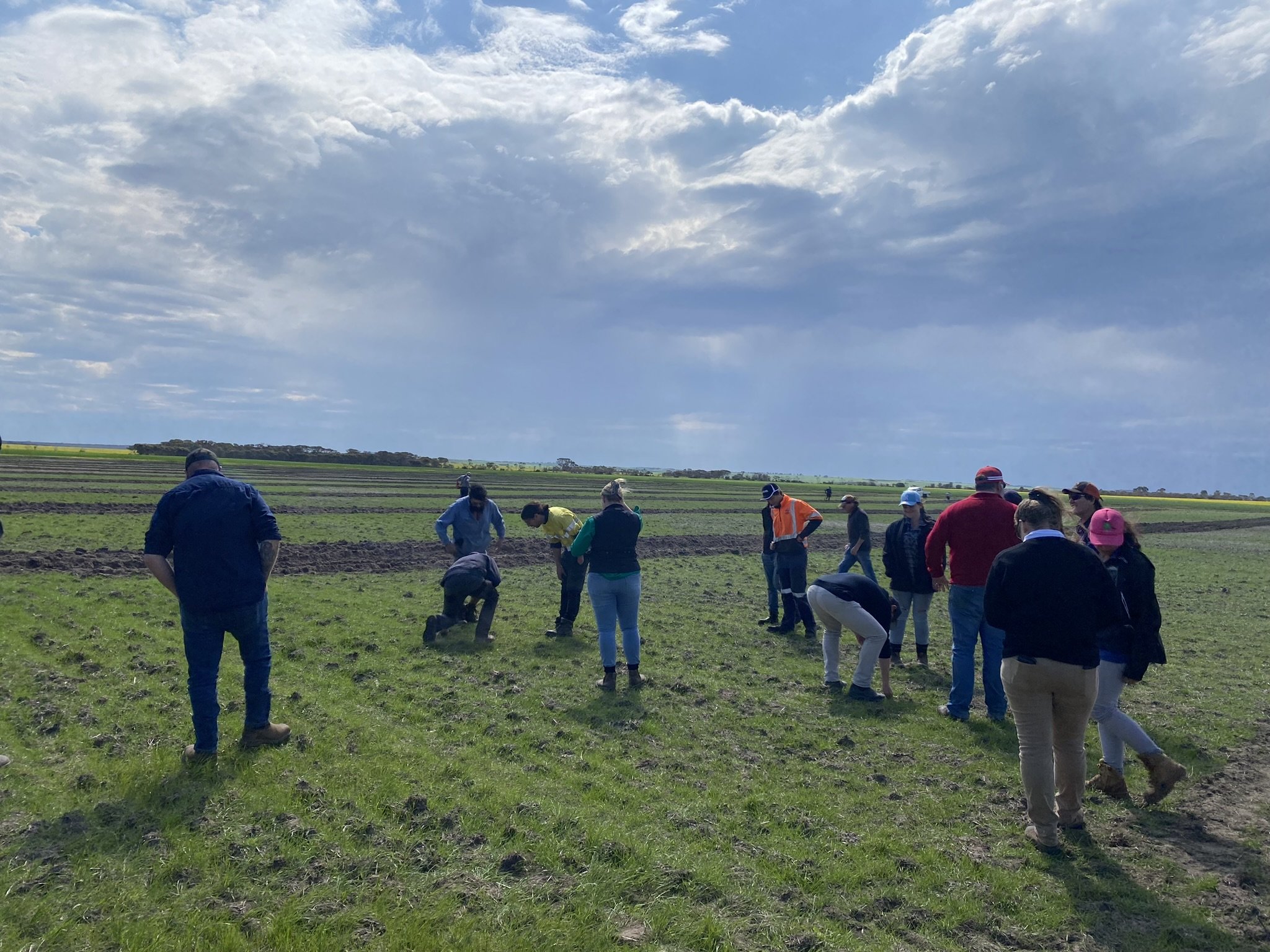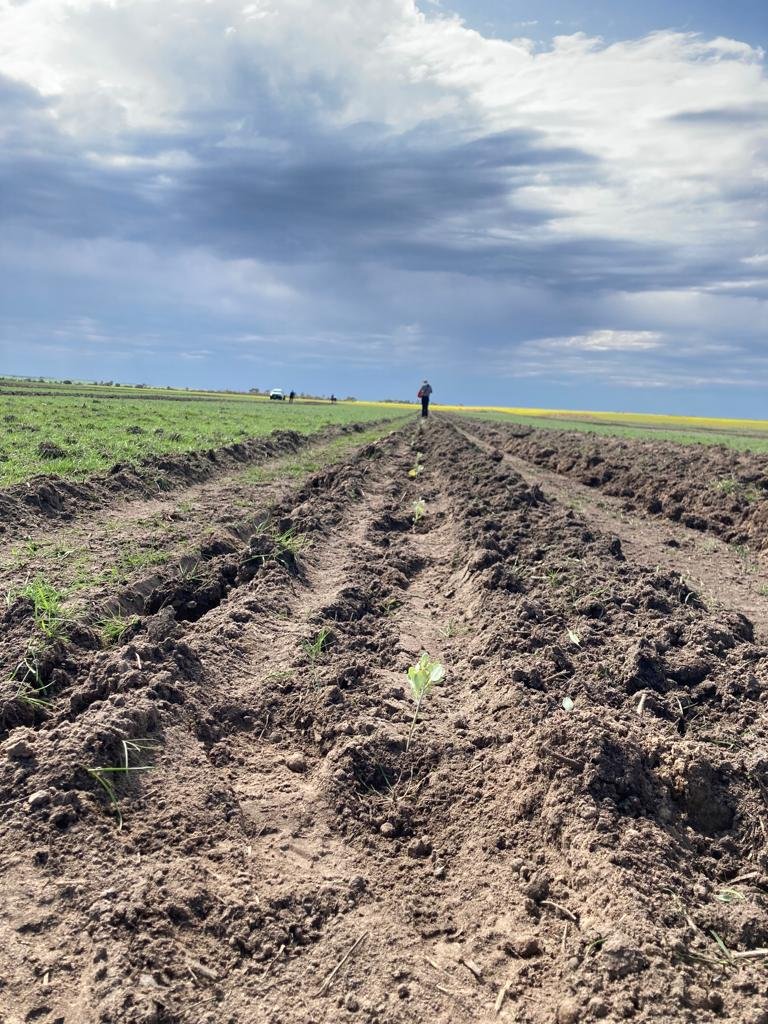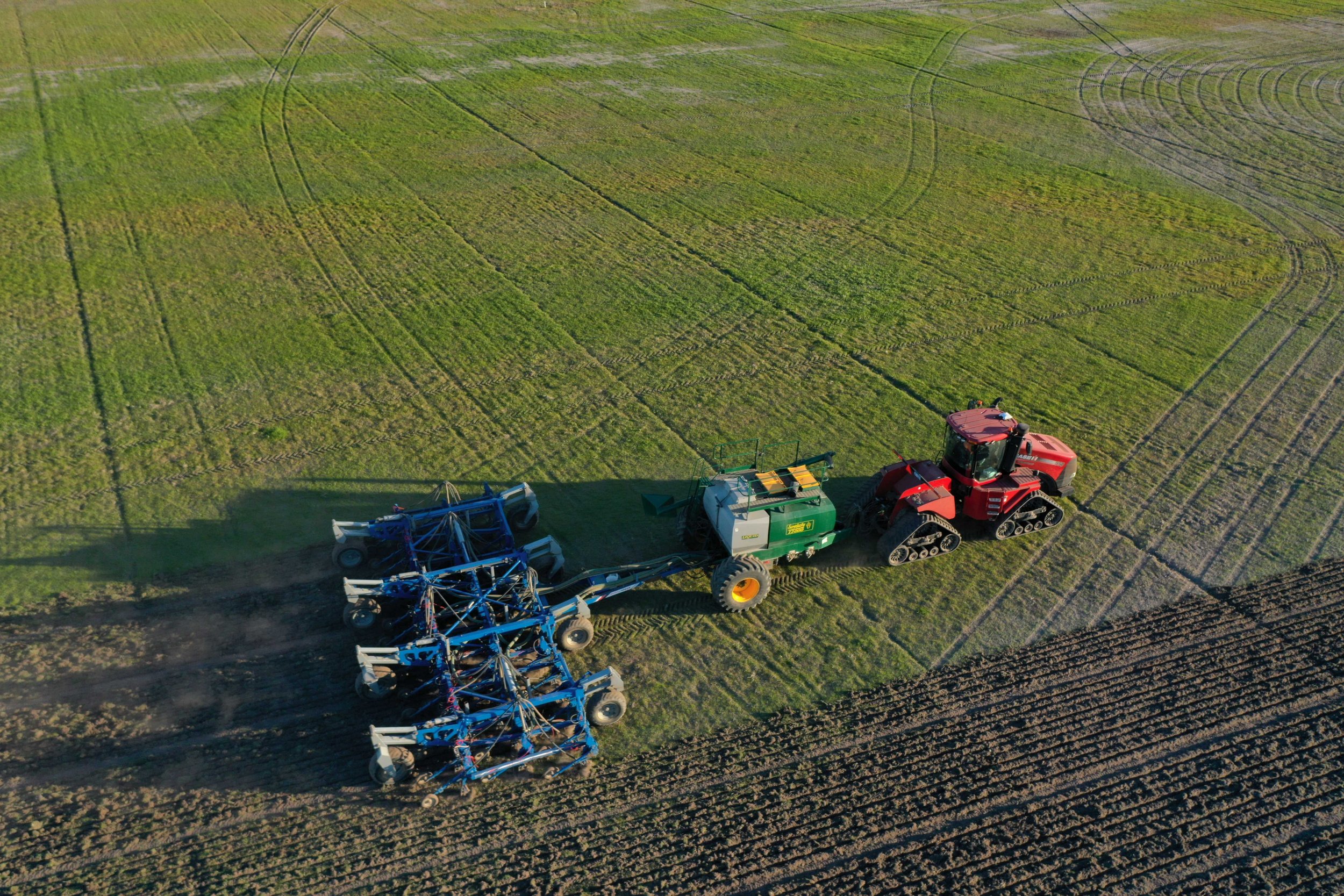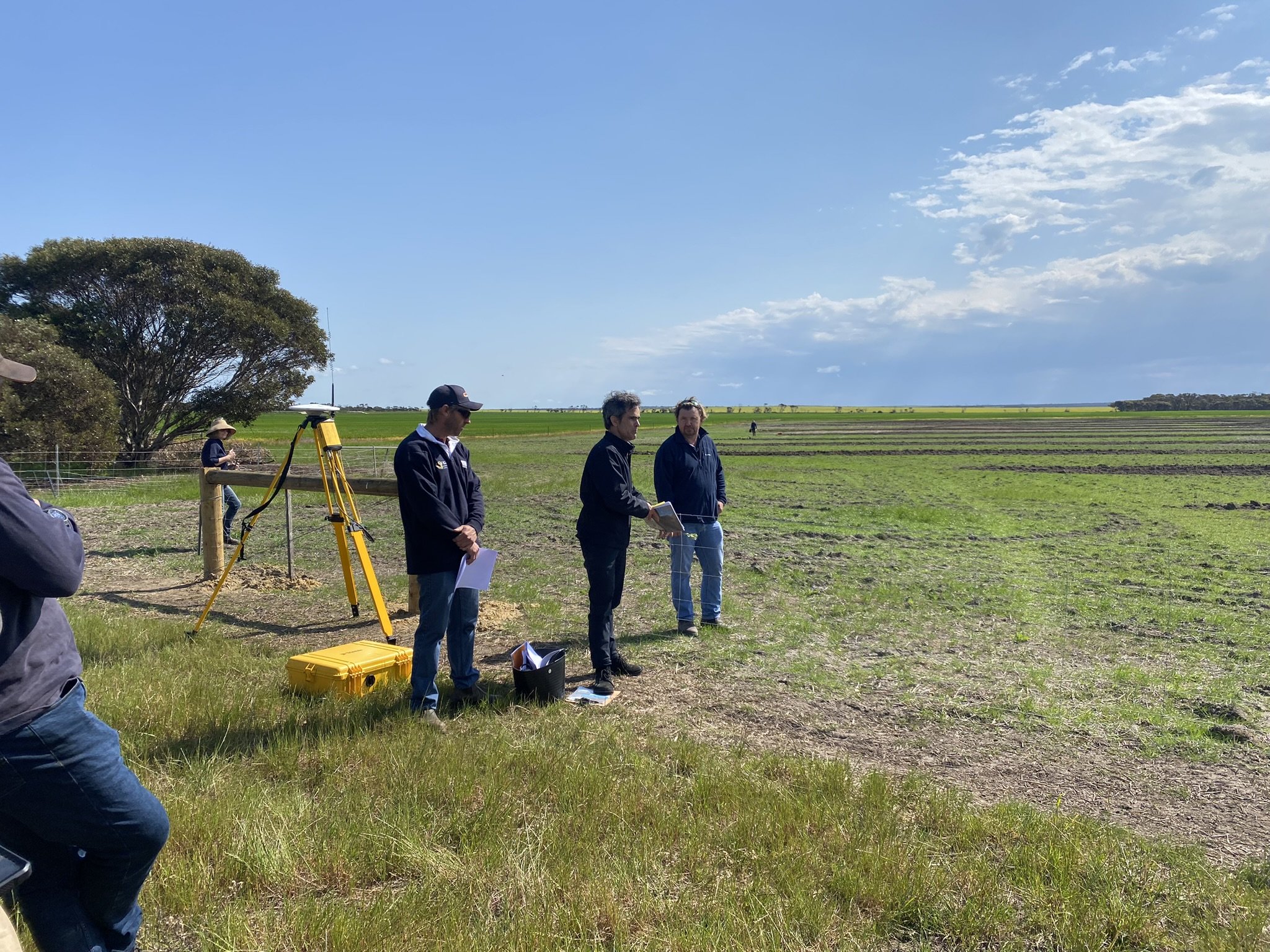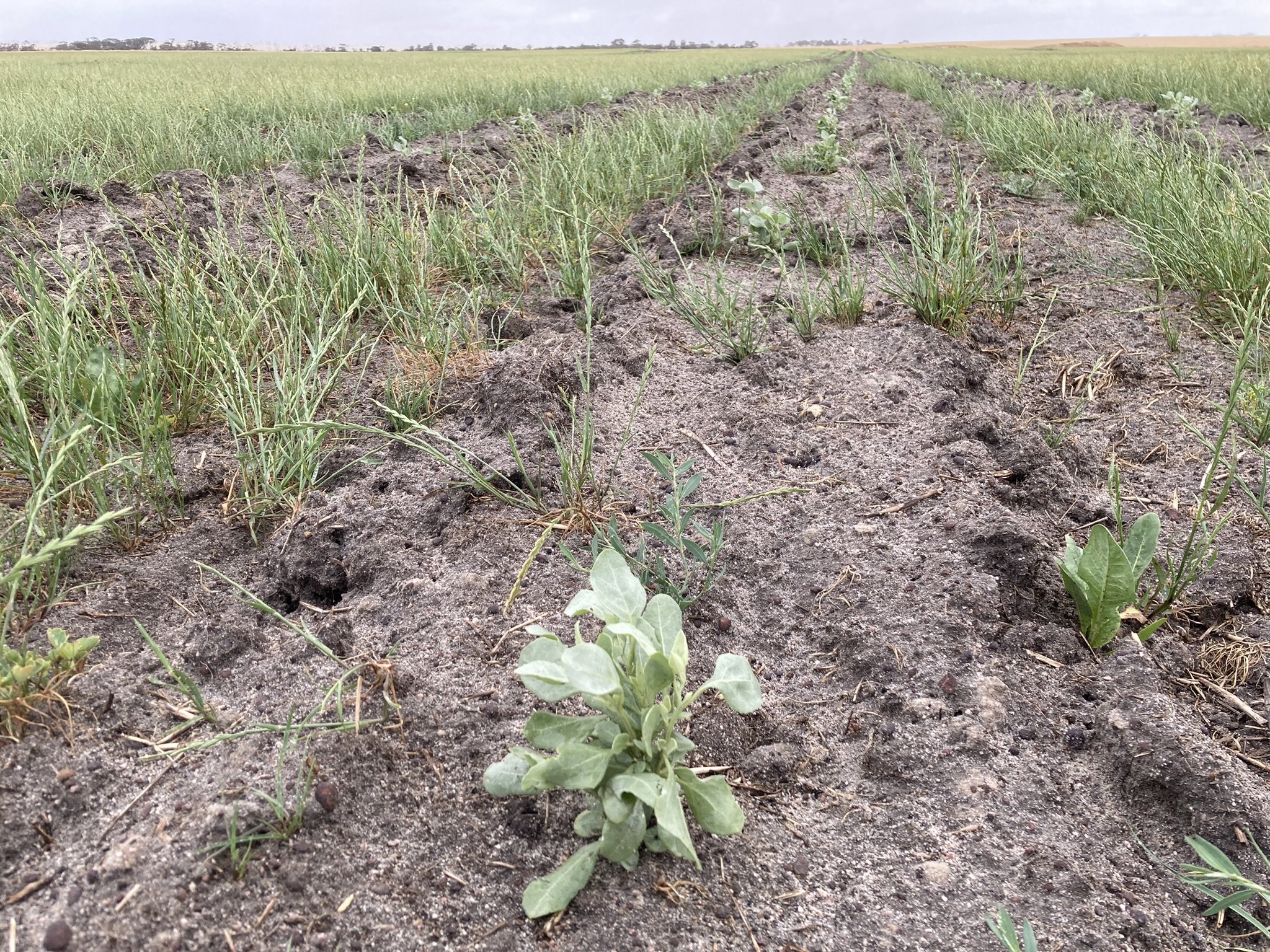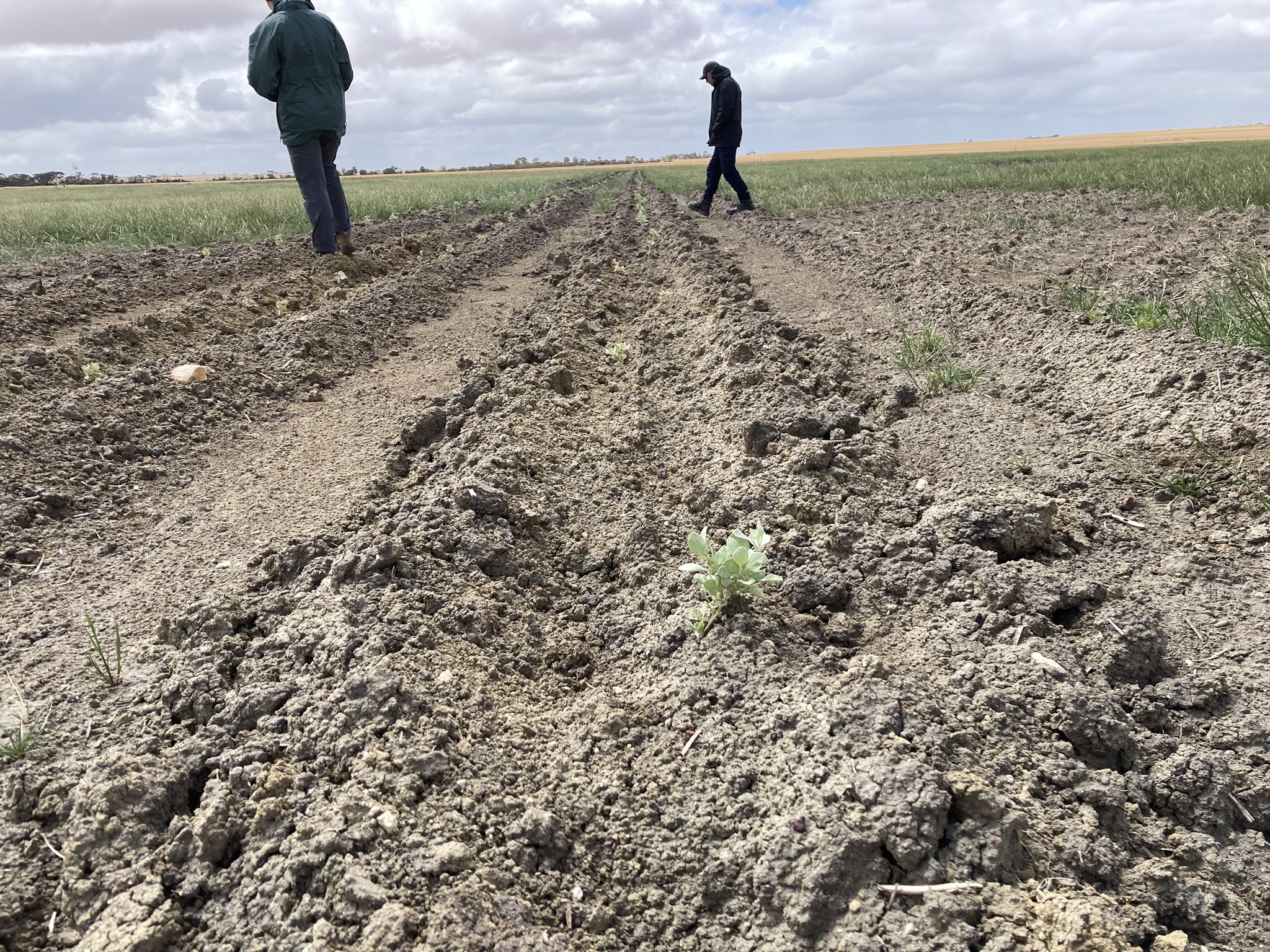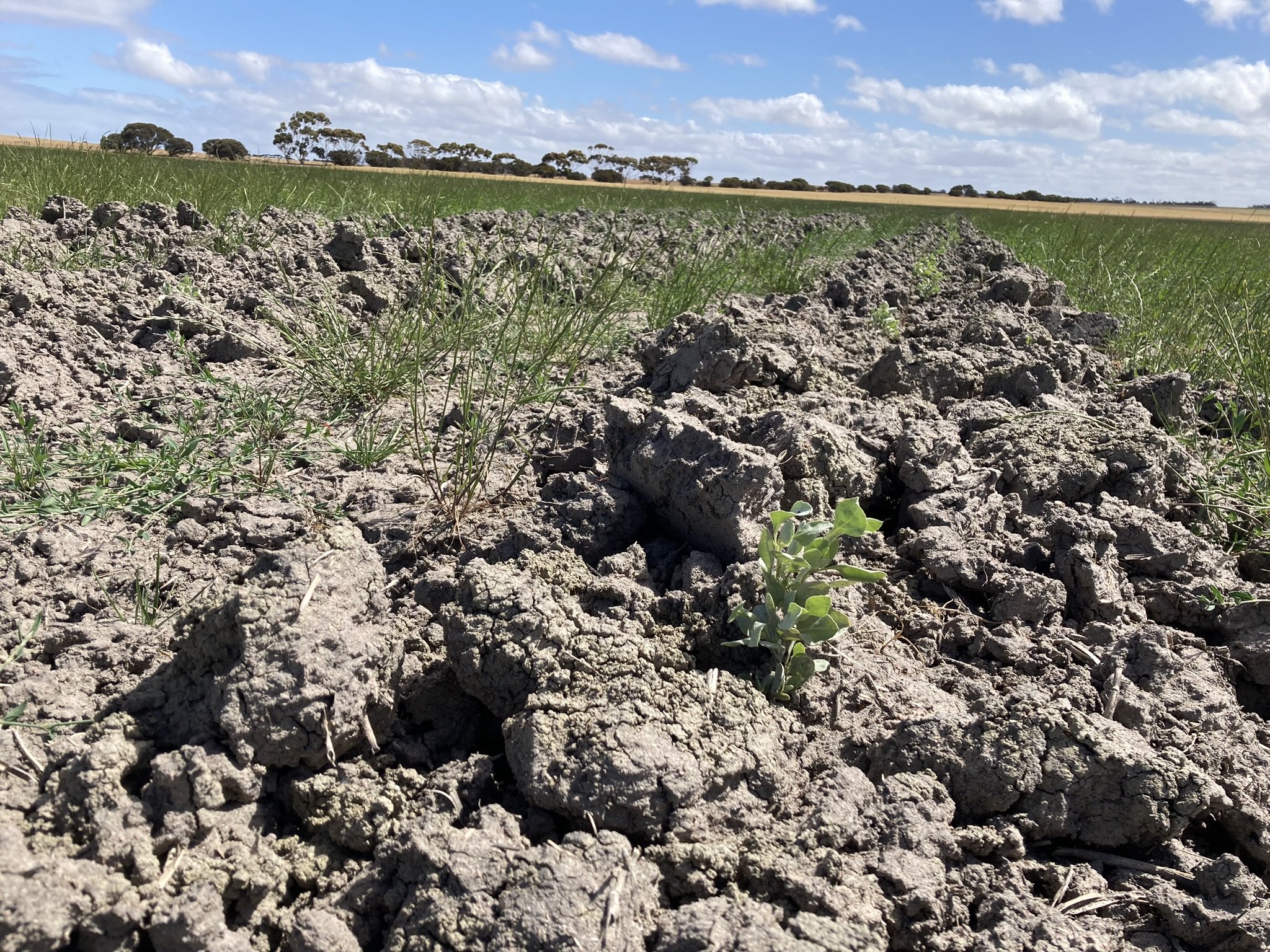Meet our Shorebirds: Protecting the Wellstead Estuary's Birdlife
Timeframe: Feburary 2022 - November 2023
Funding Source: State NRM
Project Coordinators: Leonie McMahon
SUMMARY
This projects aims to engage with community to help protect the shorebirds that breef, feed and loaf on the estuary from human disturbance, especially during the peak tourist season.
Regenerating saline land: a new approach to an old problem
Timeframe: March 2021 - October 2023
Funding Source: State NRM
Project Coordinators: Carrie Taylor
SUMMARY
The objective of this project is to address a resurgence of dryland salinity in the Jerramungup Shire using updated data and adopting a regenerative agriculture model.
In the first year of the project the emphasis will be on working closely with DPIRD and farmers to identify the current extent of salinity and collate up-to-date data and management tools. Priority areas for regeneration will be identified. At the end of year 1, and in years 2 and 3, the focus will switch to on-ground works (biodiversity revegetation and fencing) with a particular focus on practices that improve soil health.
Meet our Shorebirds: Protecting the Wellstead Estuary's Birdlife
This projects aims to engage with community to help protect the shorebirds that breef, feed and loaf on the estuary from human disturbance, especially during the peak tourist season.
Timeframe: Feburary 2022 - November 2023
Funding Source: State NRM
Project Coordinators: Leonie McMahon
SUMMARY
This projects aims to engage with community to help protect the shorebirds that breef, feed and loaf on the estuary from human disturbance, especially during the peak tourist season.
Drought resilient landscapes with profitable native shrub and legume systems across southern Australia
DROUGHT RESILIENT LANDSCAPES WITH PROFITABLE NATIVE SHRUB AND LEGUME SYSTEMS ACROSS SOUTHERN AUSTRALIA
Summary: This project involves establishing commercial-scale plantations of novel forage systems that can mitigate the impact of drought. The demonstrations will utilise and expand producer support networks to facilitate broader adoption beyond the life of the project. Collection of baseline data will allow for comparison of economic and environmental benefits to aid future adoption, leading to healthier and more drought-resilient landscapes. FBG’s involvement includes supporting the selection, coordination, and establishment of one demonstration site, coordinating two field walks, working with project partners to co-design and implement a process to capture grower feedback, and assisting with communications & the preparation of extension material.
Aim: Novel understory canopies incorporated into saltbush pasture could boost shrub productivity, thereby enhancing land function and decreasing dryland salinity risk. When combined with self-regenerating legume varieties, the profitability of low-production paddocks and salinity-prone landscapes could be improved.
Timeframe: February 2023 - June 2024
Funding Source: Future Drought Fund - Drought Resilient Soils and Landscapes Grants Program (Australian Federal Government - Department of Agriculture, Fisheries, and Forestry)
Project Lead: CSIRO / DPIRD
Project Partners: NSWDPI, GGA, Fitzgerald Biosphere Group (WA), Facey Group (WA), Central West Farming Systems Group (NSW), Rangelands Living Skin Producer Group (NSW).
Our Demonstration Site:
Title: Perennial and annual pastures with fodder shrubs to fill the seasonal feed gaps
Size, locations, and hosts:
The ~9ha site has been established in Gairdner, on Craig and Naomi Hall’s property; an area which was declared water deficient in 2020 by the Western Australian government.
Site Selection and Description:
The selection of the demonstration site was based on a few factors; it has inherent fertility (sandy loam/light sandy clay) with a history of good crop and pasture productivity. The site is prone to waterlogging that can make trafficability challenging. It is at risk of becoming salt affected due to a high (<1m from soil surface) saline water table. The site was part of the September 2020 saltland pasture Challenge Site exercise. As such an EM survey was carried out across the site which confirmed the surface (within the top 0.5m of soil profile) is currently moderately saline (125-175 EC) and over a depth of 1.5m highly saline (150 – 250+ EC).
However, soil salinity is slightly variable across the site in the eastern third ranges from fresh at the surface to mildly saline at depth. This trend in the soil salinity is confirmed from soil test laboratory results from both Fert-tech Australia as well as those test at CSBP labs (see table below). The piezometer in the middle of the paddock has a high-water table (<1.5m below the soil surface) with highly saline water quality (5500mS/m). NB seawater is: ~4700 mSm.
The site is unusual in that it is a self-contained basin high in the landscape and maybe affected by a rock barrier feature (bedrock high and/or dolerite dyke reducing the groundwater base flow and adding to the saturation of the soil surface.
Two piezometers were drilled in 2008 in the vicinity of the site. 08BREM38 was drilled to a depth of 7m and is in the middle of the study site. Successive June records over this period show that the watertable level has been 1 meter below the surface in a dry season (2020) and less than half a meter below the surface in ‘normal’ seasons. The water quality in October 2020 was 5500mS/m like sea-water concentration.
Treatment:
Site preparation:
Following a cereal crop in the previous year (2022), Craig and Naomi undertook site preparation (spraying, deep scarifying and rolling) in June, sprayed again in July, and seeded the site on 24 July 2023. The site preparation required heavy scarifying and rolling due to rut marks that had set hard from seeding equipment in the previous year.
Seeding and planting:
The site proved hard to seed earlier in the season due to getting inundated in June and becoming inundated and waterlogged, but dried out sufficiently by late July to be seeded (see drone photos). At this time, conditions were still too wet for Anameka plantings, which were instead planted on 11-12 Sept 2023.
Mixed species of perennial grasses, lucerne and chicory and a broad mix of annual legumes including the highly salt and waterlogging tolerant Messina were sown as an understory. Alleys of Anameka fodder shrubs (an elite selection of old man saltbush) are planned to be planted in triple rows 1.5m between plants and rows with a 15 m interrow. 940 stems/ha.
The final seed mix included:
Tall wheat grass (8.8 kg/ha)
Lucerne/Chicory (2.8/kg /ha) 3:1 ratio of Lucerne (3kg) to Chicory (1 kg)
Messina (5.5kg/ha)
Kikuyu (330g/ha)
Balansa clover (1.6kg/ha)
Gland Clover (1.6kg/ha)
Medic (1.6kg/ha)
Subclover (1.6kg/ha)
Vetch (1.6kg/ha)
Paradana (1.6kg/ha)
Prima (1.6kg/ha)
Cavalier (1.6kg/ha)
Scimitar (1.6kg/ha)
Dalkeith (1.6kg/ha)
RM4 (1.6kg/ha)
Tyrell (1.6kg/ha)
Inputs:
80kg/ ha Fert in 2022 (Super 3:1)
50kg/ha of Fert at seeding July 2023 (Super 3:1)
Due to site conditions the site has not had a follow up insecticide and there is some evidence of RLEM damage in the legumes (Sept 2023).
Soil nutrient status (using DPIRD nutrient calculator, to achieve a 90% relative yield)
Soil samples were collected in June 2023 by DPIRD, prior to the seeding. The soil fertility across the site is high. The high levels of macronutrients are not expected to be causing adverse effects to the plants. However, tissue testing the sub-clovers may indicate any possible toxicity effects to grazing sheep.
Surface salinity levels are high across the site, dS/m results were entered into the Soil Salinity Calculator (saltlandgenie.com) and assume a waterlogged sandy loam in the soil surface. pH levels are considered in the favourable range (5.5 – 7.5) for maximum production and allowing most nutrients to be available.
UPDATE: Spring 2023
Anameka plantings appear to have a success rate of 98%
While dominated by ryegrass and wireweed, perennials are persisting at the site. Messina, tall wheat grass, chicory, and lucerne appear most prevalent at this stage.
Use the Saltland Genie web app to help you plan your own projects.
REGIONAL LAND PARTNERSHIPS (RLP2)
Timeframe: July 2019 – June 2023
Funding source: National Landcare Program through South Coast NRM
Project Coordinators: Carrie Taylor and Leonie McMahon
Summary
In June 2019 the FBG signed the contract for years two to five of the second stage of the Regional Land Partnerships program (RLP2), with work on all projects starting in July. The projects that fall under this program are as follows:
Sub-project 1: Climate and Markets: supporting the region to adapt, innovate and address market demands for sustainable food production.
The on-ground work carried out in this project is shire- wide and includes fencing, revegetation, and annual community events.
Project Coordinator: Carrie Taylor
Sub-project 2: Environmental Protection and Biodiversity Conservation (EPBC) - Exploring new opportunities for improving the status of 20/20 priority listed threatened species in the South Coast Region Management Unit - bringing scientists, Indigenous people and NRM community together to protect threatened species.
The species in the FBG’s area of operation that meet the federal government’s criteria for this work are chuditch and Malleefowl. The corridor between the Fitzgerald River National Park and the Magenta Nature Reserve is the key area we are working in. Activities that need to be completed as part of this project over the following four years include controlling pest animals, fencing, revegetation, weed management and community engagement events.
Project Coordinator: Carrie Taylor
Sub-project 3: Coastal Threatened Ecological Communities (TEC) - Protecting coastal corridors and improving the condition of Proteaceous dominated Kwongkan Shrubland and Temperate Coastal Saltmarsh.
The TEC that is the focus of this project is Kwongkan Heath (Banksia woodland) in the Bremer Bay region. Two key activities are strategic management of Victorian Tea Tree and revegetation using Kwongkan species. In the first year, 12 ha of Victorian Tea Tree will be targeted for control. Revegetation will occur on John Street and the Meechi Road works site. Brush Mulching will be used to allow for opportunistic germination with agreeable weather eve
RECLAIMING THE MARGINS - TURNING UNPRODUCTIVE LAND INTO SUSTAINABLE GRAZING ASSETS USING THE ENRICH PROJECT MODEL
Timeframe: June 2020 - June 2022
Funding Source: Smart Farms Small Grants (Federal Government funding administered jointly by Departments of Environment and Energy and Agriculture and Water Resources)
Project Coordinators: Jess Brown
SUMMARY
This project will provide broad-acre landholders in the Shire of Jerramungup with practical support to reclaim marginal land. Our guiding model will be the Enrich research project, which assessed the edible biomass, nutritional value, health benefits and grazing preferences for 94 Australian native shrub species. It demonstrated that introducing perennial fodder shrubs into a mixed farming system has a wide range of benefits to soil health, animal health and productivity, and biodiversity.
This project will enable farmers and FBG staff to develop the expertise required to successfully revegetate vulnerable soils using native fodder species. Activities include a visit to a farm that has adopted the model, local native fodder plant identification and farm revegetation planning workshops, reviews of existing local fodder revegetation sites, dissemination of information and bringing together like-minded farmers to establish a support network and provide follow-up support.
INCREASING GROUNDCOVER TO BUILD RESILIENT SOILS IN THE WESTERN FITZGERALD BIOSPHERE
Timeframe: July 2021 - August 2022
Funding Source: Smart Farms Small Grants (Federal Government funding administered jointly by Departments of Environment and Energy and Agriculture and Water Resources)
Project Coordinators: Jolene Daniel
SUMMARY
This project has two overarching objectives. One is to increase soil health and resilience across our landscapes by encouraging farmers to experiment with new and innovative ways of maintaining continuous live groundcover on their paddocks. The second is to actively seek out and provide ongoing support to local farmers who are interested in adopting transformative NRM practices. To increase the proportion of agricultural soils under permanent ground cover we will provide incentives to adopt practices such as establishing perennial palatable native fodder species using the Enrich model and variations on it, multi-species forage pastures, pasture cropping and planned grazing management. Our area has just experienced three years of drought and climate change modelling predicts more frequent extremes of weather in the future. The activities in this project are intended to help farmers pre-empt that risk by helping their soils to help them
LOCALLY RELEVANT SPRING AND/OR SUMMER GROWN CROPPING OPPORTUNITIES FOR GRAIN GROWERS SUFFERING EXCESSIVE WINTER WATERLOGGING - SOUTHWESTERN AUSTRALIA
Timeframe: October 2021 - March 2023
Funding Source: Stirlings to Coast Farmers (GRDC funded)
Project Coordinators: Jolene Daniel
SUMMARY
The demonstration is aimed at exploring the effectiveness of spring cropping options as a management strategy for waterlogging.
Spring sown grain crops are also profitable when planted into soils at field capacity, which they were for much of the 2021 growing season in Southern WA. This new investment will be conducted in the medium to high rainfall zones of the lower Central Wheatbelt, Great Southern and South Coastal Region of WA. It will locally validate previous R&D investment relating to spring-sown crops (albeit including newer crop types and varieties), building local grower and adviser knowledge to inform decisions when managing excess soil moisture. It will focus on the critical management aspects raised by growers at the 2021 winter National Grower Network meetings. The key elements include weed, pest and erosion control in waterlogged areas, utilising excess water to produce additional grain or forage and understanding impacts on the following winter crop. Factors affecting the next winter crop may be soil moisture or salt levels, root architecture, soil nutrients and distribution.
INVESTIGATING LATE WINTER AND EARLY SPRING CEREAL CROPPING OPPORTUNITIES FOR GRAIN GROWERS FOLLOWING AUTUMN WATERLOGGING - SOUTH-WESTERN AUSTRALIA
The GRDC invested in a late sown cereal project in 2022 led by Stirlings to Coast Farmers and collaborating with South East Premium Wheat growers Association (SEPWA), and the Fitzgerald Biosphere Group (FBG). Nutrien Ag Solutions are also partners in the project and will grow and manage replicated trials at two sites in the Albany Port Zone.
PROJECT BACKGROUND:
This project will examine the viability and productivity of late winter and early spring seeding of cereal varieties in the Southern region of Western Australia. The trials will assess which varieties are most suitable to being seeded later in the season as a mitigation strategy to water logging. This Project has been developed in response to recent waterlogging events. In the Albany Port Zone in 2021 and Esperance Port Zone in 2021 and 2022, large areas of crops remained unplanted well into August and September due to the highly waterlogged soils making the paddocks untrafficable.
Growers and consultants within the APZ and EPZ have expressed a desire to know what the most profitable and productive barley and wheat varieties, and how to manage these crops when sowing so late in the growing season. However, there is no publicly available data on late sowing wheat and barley for growers to reference to help them decide what to plant in these situations. Given waterlogging is a relatively common occurrence in the APZ and the EPZ, it is imperative that farmers have resources to lean on in order to mitigate losses, and maximise the productivity that can be generated from late seeding. This project will aim to fill this knowledge gap, by providing locally relevant data that will be provided directly to local growers and consultants.
METHOD:
The project plan involves four separate small plot trials of wheat and barley with three different times of sowing for each trial site. There will be two small plot trials carried out in the Albany Port Zone (APZ) and two small plot trials in the Esperance Port Zone (EPZ).
All four trial sites will be subject to the same treatments and methodology to allow for an analysis across regions. The trial will be managed at the four sites by subcontracted trial machinery providers, with the extension, monitoring and analysis to be conducted by the contracted grower groups. The results will be anaylsed by both the grower group staff and the SAGI West.
The small plot trials will feature the following:
The cereal trial will feature 5 varietal treatments:
3 Barley – Maximus, Planet & Rosalind – 180 plants per m2
2 Wheat – Vixen, Sceptre – 150 plants per m2
Three times of sowing:
2nd week of August 1st week of Sept and 3rd week of Sept
Nutrition packages
Compound to target 14kg/ha P
Nitrogen at seeding 40kg/ha – Package 1
Nitrogen at seeding 80kg/ha – Package 2
Three TOS blocks with 12 randomised wheat treatments and 18 randomised barley treatments. Totalling 90 plots.
SCF – Optional Extra
Seeding rate trial – increase seeding rate by approx. 30% on one variety of wheat and barley.
Maximus – target density 230 plants per m2
Sceptre – Target density 200 plants per m2
Link to final report in SCF Winter 2023 newsletter can be found here
UNDERSTANDING TRENDS IN FALLING NUMBERS IN THE MEDIUM TO HIGH RAINFALL ZONES OF WA
The falling numbers test conducted on wheat assists in identifying its quality for bread-making. Low falling numbers result in down grading of wheat at receival. This is a critical issue for all growers in WA with varieties exhibiting different propensities for low falling numbers.
SUMMARY
The falling numbers test conducted on wheat assists in identifying its quality for bread-making. Low falling numbers result in down grading of wheat at receival. This is a critical issue for all growers in WA with varieties exhibiting different propensities for low falling numbers.
Research undertaken by DPIRD researchers has raised not just varietal susceptibility, but also time of sowing and the timing of rainfall as having an impact on falling numbers at harvest. In addition, Grower Network members are skeptical of the ratings given by seed companies and feel the work conducted by DPIRD researchers to date is more encompassing and therefore, accurate.
2021 is the perfect year to collect more data to assist this research in the medium to high rainfall zones of WA. There were multiple days of rain over harvest as well as a wide spread of time of sowing (TOS) dates due to early seeding opportunities across much of the grain growing region.
By June 2022, data collected will assist growers in the medium to high rainfall zones of WA to have a better understanding of how environmental, agronomic and varietal aspects impact falling number test results at harvest, and will also inform future research.
BUILDING RESILIENCE IN THE FACE OF INCREASING CLIMATE VARIABILITY
This project provides opportunities to explore ways of increasing the resilience of our farming systems.
Timeframe: June 2019 – June 2021
Funding Source: Smart Farms Small Grants (Federal Government funding administered jointly by Departments of Environment and Energy and Agriculture and Water Resources)
Project Coordinators: Various
SUMMARY
This project provides opportunities to explore ways of increasing the resilience of our farming systems.
Activities include:
· A workshop series that helps farmers build regenerative practices into their farming systems.
* One series per year for two years.
· Investigative visits to farms, organisations or conferences demonstrating greatest resilience to climate variability.
* One annual interstate trip for two FBG representatives
* Two annual intrastate trips for four FBG representatives.
Another key objective is to collate current research on climate change that is relevant to our area and have this interpreted for local use.
ONE PADDOCK CHALLENGE 2020
This project is a continuation of the One Paddock Challenge funded by State NRM. The objective of the 2020 program will be to work with up to eight farmers in the Jerramungup Shire to conduct on-farm, paddock-scale trials that have the potential to improve productivity in the region.
Timeframe: October 2019 – December 2020
Funding source: Lawson Grains and Viridis Ag
Project Coordinator: Maddy Wylie
SUMMARY
This project is a continuation of the One Paddock Challenge funded by State NRM. The objective of the 2020 program will be to work with up to eight farmers in the Jerramungup Shire to conduct on-farm, paddock-scale trials that have the potential to improve productivity in the region.
The project will:
· provide trial design, monitoring and liaison support, with a view to ensuring that the trials undertaken produce accurate, reliable and actionable data
· support farmers to accurately measure and collect data and interpret results
· work with farmers to collate and document trial outcomes in a manner that enables collaboration between farmers and sharing with the local farming community.
· link farmers and researchers
· seek information about existing trials on other farms that are of particular value to the wider community, and support receptive farmers to gather more data.
Trials will focus on increasing resilience in farming systems in the face of increasing climate variability by:
· trialling and introducing new agronomy practices and to the region
· improving on existing practices
· demonstrating proven research in a local context.
Final report available here
STRATEGIC CONTROL OF PRIORITY ENVIRONMENTAL WEEDS IN BREMER BAY
This project will focus on control of a number of environmental weeds in Bremer Bay, including two weeds of national significance: boxthorn and bridal creeper.
Funding Source: State NRM
Project Coordinator: Therese Bell
Timeframe: January 2020 to January 2021
SUMMARY
This project will focus on control of a number of environmental weeds in Bremer Bay, including two weeds of national significance: boxthorn and bridal creeper. Weeding bees will focus on high priority areas and target species identified as being of greatest concern by local residents, including (but not limited to) African Lovegrass and Polygala, in addition to the weeds of national significance. Victorian Tea Tree control will be carried out in another associated project.
Activities will include:
• Removal of several significant infestations of boxthorn from strategic (high priority) bush remnants.
• Training workshop to upskill more local volunteers to distribute bridal creeper rust and conduct long-term monitoring.
• Busy bees to distribute bridal creeper rust.
• Regular busy bees in high priority native bush to remove other weeds of highest concern using volunteers from different sectors of the community including FBG subgroups, local residents, schools, tourists.
• Establishment of a demonstration site in a high visibility area to promote awareness of
weed issue, encourage community ownership and engagement and monitor change.
• Community awareness program targeting local residents, businesses, schools, tourists
• Ongoing liaison between stakeholders.
WEED ACTION GROUP IN BREMER BAY
This project will complement the State NRM funded project: Strategic Weed Control in Bremer Bay and the Regional Land Partnership work on Victorian (Coastal) Tea Tree.
Funding Source: Communities Environment Program
Project Coordinator: Therese Bell
Timeframe: November 2019 to December 2020
SUMMARY
This project will complement the State NRM funded project: Strategic Weed Control in Bremer Bay and the Regional Land Partnership work on Victorian (Coastal) Tea Tree. It will allow for more weeding busy bees over a larger area, providing the opportunity to make a more substantial impact on weed control in priority areas.
Sub Soil Constraints
In the Subsoil Constraints project, FBG worked closely with DPIRD and other groups in the Albany Port Zone to deliver media, coordinate extension activities and provide landowner trial sites and grower feedback to seek better ways of identifying and managing constraints through amelioration and mitigation.
Timeframe: September 2014 to September 2019
Funding source: Grains Research & Development Corporation, administered through Department of Primary Industries and Regional Development
Project Coordinator: Maddy Wylie.
DPIRD staff: Jeremy Lemon, Glenn McDonald, David Hall
Summary
In the Subsoil Constraints project, FBG worked closely with DPIRD and other groups in the Albany Port Zone to deliver media, coordinate extension activities and provide landowner trial sites and grower feedback to seek better ways of identifying and managing constraints through amelioration and mitigation.
Project overview and outcomes
Subsoil constraints were identified as a major concern for many grower groups of the South Coast and Southern Wheat belt region of WA. They inhibit root development and function and in doing so limit crop growth and production through restricted access to water and nutrients.
As a consequence of these natural and induced conditions, subsoils in WA are inherently prone to acidity, nutrient disorders, low water retention, compaction and alkalinity/boron/salinity alone and in combination. The cost in lost production associated with these subsoil constraints is estimated to exceed $600 million per year.
The activities carried out during the five years of this project were as follows:
2015
Field Investigations. The FBG coordinated four site visits to local farms by DPIRD staff to assess their suitability for sodicity trials. None were selected.
Workshops and site visits: How’s Your Roots Going? Field walk attended by over 50 people at the Harding family farm at Corackerup. Joint event with North Stirlings Pallinup, with another field walk held at Broomehill. Participants looked at a Controlled Traffic Farming (CTF) system put in place by the Hardings, as well as a deep ripping trial and some other proof of concept trials being run by DPIRD.
2016
Field Investigations – sites visited by DPIRD
Stu and Leanne Bee, Jacup
Site was used to investigate single rate gypsum, with ripping to 400mm using inclusion plates. This was a small plot trial.
Season was very wet and trafficability was an issue.
Lawson Grains – Gunnadoo, Jacup
Site investigation was delayed by wet weather. By the time conditions were dry enough, tractors were being used for seeding and not available for DPIRD usage.
Ripping strips closer to Jerramungup were to be monitored, but this option proved not to be viable due to weather in that year. Management change also saw shift in focus.
Workshops and site visits: FBG Spring Field Day: A soil pit was dug at the site of FBG’s Nutrition Trial at Trent and Tina Parson’s farm, 5km south of Jerramungup. Jeremy Lemon spoke about soil health issues, and it was a good opportunity for growers to discuss subsoil constraint issues directly with him
2017
Field Investigations – three sites were suggested to DPIRD for further investigation
Workshops and site visits
Proposed pop-up soil health site visit – did not proceed
Australian Controlled Traffic Farming Association Tour
As part of the southern tour taking place as part of the ACTFA Conference, a site visit was arranged to the Harding DPIRD trial.
Members were able to attend this part of the tour which was attended by an additional 10 farmers from the area.
Spring Field Day
Two soil pits were dug – one at Lawson Grains, Jerry South, and the other at the Keding family farm
Jeremy Lemon gave an insight into the soil issues faced at each site.
DPIRD Trial Site at Corackerup
2018
Farmer Investigations: A growing interest in deep ripping and looking for local results and solutions led to an increasing number of farmers conducting their own on-farm trials, for deep ripping and other strategic tillage options. A couple of these sites were visited as part of the FBG’s Spring Field Day.
Workshops and site visits
Elders Wilchem Field Day, Jacup
Soil pit dug at site deep ripping by DPIRD in 2016.
WANTFA/DPIRD/ACTFA CTF Workshop, Scaddan
Attended by Project Officer – looked at renovated tramlines in CTF systems.
GRDC RCSN Open Forum, Jerramungup
Subsoil priorities were: Non wetting soils; Identifying which soil amelioration technique will return best value for money; Liming; Farming systems to combat erosion
Spring Field Day, Jacup
two soil pits dug at Stu Bee’s (same location as for Elders field walk), as well as at Mick and Mark Lester’s where they had used a DBS deep ripper earlier in the year.
Subsoil constraint discussion led by Glenn McDonald.
2019
Farmer Investigations Multiple on-farm trials for deep ripping, delving, spading, etc. were carried out by farmers in the district, including the ones mentioned above and others.
Workshops and site visits
GRDC Difficult Soils Forum, Jacup
Coordinated by GIWA, this workshop came about due to the RCSN priorities raised by growers attending their feedback sessions.
It has been generally agreed that soils on the South Coast are very challenging and where there are multiple constraints, the well-researched prescriptions can be hard to apply.
Well attended day, with more than 40 farmers and industry in attendance. Soil pits dug at Mick & Mark Lester’s, as well as Lawson Grains, Gunnadoo.
Landmark Subsoil Constraints field visit, Jerramungup
Coordinated by Advisory (now Board) Member, Kyran Brooks, this well-supported day brought together DPIRD researchers from the South Coast, as well as Northern researchers, such as Wayne Parker and Bindi Isbister, to discuss the multiple constraints and difficulties faced by farmers in the area.
One Paddock Challenge
FBG’s One Paddock Challenge set out to equip farmers with the skills to conduct their own paddock-scale on-farm trials. It also aimed to increase the capacity for peer-to-peer learning.
Timeframe: September 2016 to March 2019
Funding source: State Natural Resource Management Program
Project Coordinator: Maddy Wylie
Summary
FBG’s One Paddock Challenge set out to equip farmers with the skills to conduct their own paddock-scale on-farm trials. It also aimed to increase the capacity for peer-to-peer learning.
It was found that farmers had a keen interest in trialling their approaches on a whole paddock scale. This seemed more meaningful than a plot-sized trial as lessons learned could be applied more easily to a farming system than what was perceived as being a more controlled environment. Trials which allowed for discussion and participation from peers, or where something different to the norm was trialled, were those that invoked the most discussion.
A trial management workshop, run by Nigel Metz, was run early in the project to give farmers the framework to formalise their existing on-farm trial endeavours.
Key learnings from the project included highlighting the important of good planning and trial set up as in almost all activities undertaken there were factors which led it to vary from its original plan. While this may not necessarily be an issue, it can take away from the trial’s validity.
The growth in importance of social media and the ease with which farmers can communicate through these channels, particularly through avenues such as Twitter, also open up greater opportunities for the dissemination of ideas, information and the establishment of virtual communities.
Other aspects of the project, such as the development of a new FBG website and seeking alternate sources of funding play into this social media and communication role, as the requirement to be active and relevant in the agricultural research, development and extension space is a vital role for FBG as a grower group promoting and supporting member interests.
Leading on from the conclusion of the One Paddock Challenge, there are a number of avenues that could be explored further, although the enthusiasm of our farmers and their continual drive to learn and improve their all aspects of their farming businesses is ultimately what will drive further grassroots research in the FBG membership area.
Project details and outcomes
Pete and Jolene Daniel – Long Season Canola
Concept: Pete and Jolene Daniel were interested in trialling long season canola due to its extensive root system and ability to access nutrition. Ultimately, the aim was to increase soil carbon levels, and thereby improve water and nutrient-holding capacity.
Findings: The trial paddock was seeded in October 2016 into what was believed to be a good soil moisture profile given rainfall received in that year. However, rainfall did decline from August onwards in that year. Seeding also resulted in clods being brought to the surface and poor seed-soil contact.
Outcome: The paddock was ultimately grazed in February 2016 and not taken through to harvest.
Andrew Wylie – Lawson Grains, Jerry South – Lentils
Concept: Andrew was looking to trial an alternate and profitable break crop to canola in a 100 per cent cropping model operated by Lawson Grains. The most profitable and reliable rotation has historically been wheat, barley and canola. However, there are many benefits to running a more diverse cropping program, and 100 hectares of Hurricane lentils were put into the program in 2017.
Findings:
Lentils did not nodulate well
Early vigour was not strong
Plants did not perform well on some soil types across the paddock
Good fungal control and little in the way of disease or insect attack
The crop was harvested using a rigid front (rather than flex) which resulted in significant amounts of grain being left on the ground
Limited marketing opportunities
Outcome: crop performed reasonably, yielding one tonne per hectare. It warranted further trialling, although using a different variety (Bolt).
Noel Keding – Deep Ripping and Liming
Concept: To trial deep ripping in some mildly non-wetting soils, as well as look at different liming options; Lancelin lime and Hi-Cal lime.
Findings: There was negligible difference between ripped and non-ripped plots, and slower plant establishment on areas that had been deep ripped (some clodding apparent).
Noel thought that he would look at trialling deep ripping again in the future, but would be more selective in site selection, particular given the expense involved in the process, in terms of time and labour. HiCal lime plots performed better overall than those limed with Lancelin lime.
Outcome: Noel has been using liquid fertilisers, Calsap and HiCal, for some years as part of his farming system. He believes this is helping to improve soil health and plant root depth. The lack of difference between root depth in the ripped and non-ripped plots served as validation for some of his farming decisions.
Mark and Mick Lester – Lucerne
Concept: Lucerne is widely regarded as being a good fit for many mixed farming operations. It is a tough perennial pasture, with the ability to produce large amounts of high quality feed as well as building nitrogen within the soil for future use by cash crops. It can help in running down weed seed banks and its deep root system can penetrate hostile subsoils opening up.
Findings: The Lesters used seed they had on hand that they had harvested three years previously. This resulted in patchy germination. The crop was seeded in 2015.
Outcome: The Lucerne stand persisted through the establishment period despite some patchy germination and has been used strategically for the Lester’s grazing operation, as well as being effective in alleviating salinity issues in that area.
Stu and Leanne Bee – Vetch
Concept: The Bees were looking for more robust legume-based options to reintroduce nitrogen into their soils without the expense of having to plant and establish Lucerne. The appeal was to look at an annual legume where the seed source is cheaper or could be grown on-farm or regenerated after three or four seasons. Woolly pod vetch best fit the brief. In addition, research by DPIRD scientist, Dr Angelo Loi has demonstrated that it can provide enough nitrogen for up to three subsequent seasons.
Findings: A dry start to the growing period meant that establishment was slow. Additionally, the paddock was grazed in June 2017, impacting on early season biomass. It didn’t really recover. While the paddock used for the trial had some set-backs, it was not representative of how vetch has performed on the Bee’s farm as a rule.
Its use as a weed management tool cannot be underestimated either. It enables grasses to be sprayed out in the paddock, while sheep continue grazing. This allows the paddock to be utilised to a greater extent while decreasing the weed burden.
Outcome: Stu and Leanne continue to use woolly pod vetch (such as Capello or RM4) as part of their rotation for the following reasons:
Versatile high production, low input crop
More tolerant of acidic soils than most grain legumes
Nitrogen fixing benefits
Weed control options
Brad Bailey – Airseeder Demonstration
Concept: Brad had been considering changing over his existing Flexicoil ST830 airseeder bar due to increasing requirements for repairs and maintenance, both in terms of money and time spent repairing it. He was also looking to increase accuracy of seed placement and ensure good germination.
Given the large outlay required in the investment, Brad was keen to compare some different options on his own farm, working in with some neighbours. This was a demonstration of different owner-operator seeding set-ups. It encouraged discussion and participation.
Findings: On 2nd June 2017, four different airseeders were part of the community-based airseeder demonstration. Brad’s Flexicoil bar was used, as well as the McKinlay family’s Bourgault 8910 Culti Drill, Mick and Mark Lester’s Ausplow DBS D300-44, and Tim Bock’s Chamberlain 275 unit. In 2018, the Chamberlain machine was replaced by Mal Smith’s Vaderstadt Seed Hawk SH1220.
Outcome: Along with other grower-led seeder demonstrations, the results of the trial undertaken did not directly influence the purchase decision. However, the gathering of farmers for the event, as well as subsequent field walks encouraged engagement in the peer-to-peer learning experience allowing growers to gather, discuss and learn from one another in an informal environment.
Wade Brown – vetch pastures
Concept: For his One Paddock Challenge, Wade was looking to grow vetch under-sown with canola. The paddock chosen had some issues with grass weeds, and he wanted to add some natural nitrogen back into the cropping system, as well as filling the spring feed gap.
Findings: The trial paddock was sown to vetch under-sown with canola to alleviate some subsoil compaction as well as providing some bulk to the pasture base. However, the implications of its inclusion were not measured as part of this activity.
The plant stand established well in 2017 and in September was grazed with 1200 ewes and lambs before being sprayed out.
In 2018, the subsequent wheat crop yielded 0.8t/ha more than the average of other wheat crops on the Brown’s farm, with good protein and a grade of H2 on average. The wheat crop was not top dressed.
Outcome: For the Brown family, this system works very well in their predominantly sheep focussed enterprise. It provides a break in their cropping system for weed and disease management, although they do forgo cash income for this phase as they use the vetch as a pasture to wean lambs onto.
Damon Parker – liquid carbon farming systems
Concept: In 2012, the requirement to outlay money on new fertiliser infrastructure at an outlying block was the catalyst, along with a dissatisfaction with the performance of the status quo, for Damon to consider his fertiliser options. Damon was interested in enhancing the soil system by adding carbon and other stimulants to the subsoil.
Additionally, the enhancement of carbon in building soil capacity cannot be underestimated in increasing both food production, but also in ameliorating the effects of climate change.
Findings: In 2012, Damon converted his farm to a whole systems liquid carbon approach. He received widespread recognition in his agronomy support network in 2015 and 2017 for the marked increases in his wheat, canola and lupin yields.
Outcome: As Damon had been operating for several years in this manner across his whole farm, the paddock chosen for the One Paddock Challenge did not have a strict control strip. In order to have some comparison, a compromise was made whereby fertiliser was not applied to a two-hectare strip in 2017 and comparing against the area next to it. As it turned out, 2017 proved to be a good farming year for the Parker family and there was not a marked difference between the two sites.
Linking Bremer Bay to Point Henry Trail
This project was a partnership between the Fitzgerald Biosphere Group, the Bremer Bay Regional Trails Committee and the Shire of Jerramungup. It completed a dual use path between the town site of Bremer Bay and nearby Point Henry Peninsula.
Timeframe: May 2017 – June 2018
Funding sources: Lotterywest, Great Southern Development Commission, through Shire of Jerramungup and Greenskills Albany.
Project Coordinator: Therese Bell.
On-site coordination: Nathan McQuoid
Summary
This project was a partnership between the Fitzgerald Biosphere Group, the Bremer Bay Regional Trails Committee and the Shire of Jerramungup. It completed a dual use path between the town site of Bremer Bay and nearby Point Henry Peninsula. The asphalt path was laid by the Shire in 2015 and 2016. In this 2017-18 project managed by the FBG a loop trail, interpretive and directional signage, lookout points, a sculpture of the local native snail and stone wall seating were added. The trail was officially opened in March 2018.
Project details and outcomes
The dual-use asphalt path runs approximately parallel to, and along most of the length of, Wellstead Rd between Point Henry Peninsula Rd and the Bremer-Borden Rd.
A 600m crushed limestone loop trail was constructed off this main path, as were short spurs to two prime lookouts. Lay-bys were created at four suitable resting points. Seating in the form of low rock walls was constructed by a local stonemason at the lookout and resting points. A super-sized sculpture of the South Coast Native Snail Bothriembryon melo was installed at one of the resting points and a directional dial was installed at one of the lookouts.
Interpretive panels to explain the landscape through which the path winds, were installed on stone plinths and covered the following subjects:
Yandil Woodland
Crowned Snake
South Coast Native Snail
Sandy Shrublands
Bush Rat
Swamp Yate, Mor
Directional signage and trail head signs were also erected. A brochure which promoted this and other trails in the Bremer Bay area was completed as part of the project.
A study into the feasibility of branding ethically and grass-fed red meat for export market recognition
The intention behind this project was to investigate ‘Paddock to Plate’ opportunities for our meat sheep producers in domestic and export markets, primarily Perth and China.
Timeframe: June 2016 to February 2018
Funding sources: Core project funding: Agricultural Sciences Research and Development Fund, administered by the Department of Primary Industries and Regional Development and supported by Royalties for Regions investment.
Support funding (for consumer surveys in China): Regional Development Australia Great Southern WA
Staff: Dr John Gountas, PhD, Associate Professor in Marketing from the School of Business and Governance at Murdoch University, for survey and market analysis.
Paul Sanford, Senior Researcher, Department of Primary Industries and Regional Development, Albany, for research and technical support.
FBG support: Leonie McMahon
Summary
The intention behind this project was to investigate ‘Paddock to Plate’ opportunities for our meat sheep producers in domestic and export markets, primarily Perth and China. To make an informed decision, the producers needed to know if there was a market demand for grass fed lamb, consumer preferences, ways of negotiating the supply chain (producers, distributors, retailers and consumers) and strategies for entering into the market.
Throughout the project consumers in Western Australia, Australia and two Chinese cities were surveyed and their responses analysed. Producers met several times with marketing expert, Dr John Gountas, to discuss the data and formulate opinions as to whether or not the Paddock to Plate concept was feasible for their businesses.
At the conclusion of the feasibility study, the group decided not to pursue the Grass Fed Lamb concept. Two of the main recommendations to come out of the study: that a small group of key FBG producers invest significant funds up-front to purchase a mobile abattoir, and to develop and finance an annual marketing campaign, were significant factors in this decision.
Project details and outcomes
The grass-fed lamb feasibility study was successfully completed in February 2018 with all of the main project objectives being achieved. The key findings from the survey and supply chain analysis were:
There is a growing market sector of consumers who value the perceived superior quality of grass fed meat, the superior taste, quality of texture, trust and security of meat safety, superior nutritional value, and environmentally sustainable animal raising conditions.
There is premium value associated with telling the story behind the product, and in marketing and selling directly to the consumer, both locally and in South East Asia where demand for Australian sheep meat is increasing.
However, it was strongly recommended that FBG producers focus on developing a strong domestic brand and an effective processing and distribution system in WA before considering entry into Asian markets. The Chinese market is considered particularly risky because it is fragmented and difficult to penetrate. There are major obstacles that would need to be overcome and investment costs are high.
Processing is the key challenge for regional producers with product availability and value chain infrastructure likely to pose serious problems. The current oligopoly of meat processors does not provide enough flexibility to kill, butcher, process and distribute for small farmers in the Great Southern. Large distances between farms and processing plants result in higher distribution costs and stress to animals and farmers.
Promotion of grass-fed meat products in WA and Australia is currently almost non-existent. Promotional campaigns should focus on the core attributes of healthy and safe meat product with superior taste. The emphasis and focus need to differ for Australian and Chinese consumers.
The most popular branding options identified in the surveys were: “Totally Natural 100% Grass fed Lamb” [or sheep meat]; and “Grass fed Australian Lamb” [or Sheep meat].
Branded meat products generate better financial, environmental and social returns and are more sustainable in the long term against economic and trading upheavals. The future of WA meat producers and distributors would be more secure if they developed branded sheep meat products and built strong national and global brands with strong vertical alliances and networks to connect efficiently with the customers. FBG farmers would need to work closely together to achieve this.
Throughout the course of this project FBG producers interested in the concept met three times, initially to discuss the feasibility parameters with the marketing expert, then later to learn about interim results and then thirdly to further discuss the future of the project. These meetings, one of which was attended by Chinese exporters, provided opportunity for FBG producers to expand their understanding of consumer sentiments, market development and the supply chain. These opportunities gave rise to much discussion and strategizing, identification of issues, solutions and market opportunities.
Managing soil carbon and nitrogen in kikuyu pastures in the Fitzgerald Biosphere
The objective of this four-part project was to investigate ways of reducing nitrous oxide emissions whilst increasing soil carbon stores in South Coast farming systems.
Timeframe: June 2016 to February 2018
Funding source: Action on the Ground: Australian Government Department of Agriculture
Project Coordinator: Karryn Dorrell.
Partners (providing technical support): Department of Agriculture and Food WA, University of Western Australia Centre for Excellence in Natural Resource Management, University of Queensland.
Additional support: South Coast NRM
Summary
The objective of this four-part project was to investigate ways of reducing nitrous oxide emissions whilst increasing soil carbon stores in South Coast farming systems.
The aim of the first sub-project was to compare nitrous oxide emissions from different companion legumes grown into established kikuyu pasture to identify the best options for reducing reliance on nitrogen-based fertilisers. This sub-project ended early when poor seasonal conditions resulted in insufficient establishment of the legume varieties that were to be compared.
The aim of the second sub-project was to monitor nitrous oxide emissions when synthetic nitrogen was applied to clover and kikuyu pastures. Results were variable due to a number of constraints, but showed an increase in soil carbon in the sites that were fertilised with synthetic nitrogen.
The aim of Sub-project three was to compare carbon sequestration capabilities of soils under three different growing regimes: established perennial pastures, annual pasture and cropping. Results showed there was little difference in carbon fixation between them.
The objective of the final sub-project was to establish eight baseline carbon sequestration sites on newly sown perennial pastures. More than 700 ha of perennials were sown on eight properties across the region. Baseline soil carbon measurements were taken, with the long-term view of using the data in future carbon monitoring projects.
The short (17 month) experiment timeframe was one of the main limitations of the project.
Project details and outcomes
Sub-project 1 Establishment of a large-scale key demonstration site that would trial a broad range of legume options and identify the better performing legumes in kikuyu-based pastures.
Trial location: Gairdner, WA (65 km from Jerramungup)
It was intended that once established, the persistence and productivity of the different legume varieties would be compared, and the impact the presence of legumes had on sward production in the kikuyu would be measured. The legumes sown, as both pod and seed, and at varying densities, were: Avilla, Bladder Clover, Margarita and Charano.
The decision was made to end this trial early when the legumes failed to establish in the first half of 2014 due to insufficient rain.
Sub-project 2: Monitoring of nitrous oxide emissions when synthetic nitrogen is applied to clover and kikuyu pastures.
Trial location: Gairdner, WA (approximately 50 km from Jerramungup)
The objective of this sub-project was to set up small trial plots in existing clover and kikuyu pastures and compare pasture productivity and nitrous oxide-nitrogen gas flux emissions after different synthetic nitrogen treatments were applied. The nitrous emission monitoring started in August 2013 and was conducted seven times, coinciding with rainfall events of above 10 mm.
Biomass estimates were highly variable and there were no significant differences across the treatments. Nevertheless, trends in mean data suggested clover was more productive than kikuyu and the nitrogen treatments were more productive than the controls.
There was high variability in the results, attributable to several factors, the most important being small field plot size, the strong non-wetting nature of the soil type, the sporadic nature of the denitrification process and the inherently high spatial variability of soil processes in undisturbed pasture soils.
The greatest constraint was the short duration (17 months) of the pasture treatments. Unfortunately, this short time period meant no contingency options for analysis delays and other unforeseen issues that were encountered.
Sub-project 3: Determination of carbon sequestration capabilities of soils with established perennial pastures (compared with annual pasture and cropped soils).
Four farming families, whose properties represent different rainfall zones, geographical locations and soil types, participated in this trial. Carbon levels in the soil and pasture growth were measured and compared with adjacent paddocks that had annual pasture or were being cropped.
Total organic carbon content in the soils tested were at moderate to good levels. Of note, none of the participants strained their perennial systems or over grazed their annual pastures, particularly during the summer months when all soil types in the southern region of Western Australia are susceptible to topsoil loss through wind erosion.
The comparison study was the most interesting component of this investigation, with the two cropping versus perennial rotations returning the closest difference in carbon sequestration data to the perennial pasture within the top ten centimetres. Carbon content from deeper within the soil (0-30cm) consistently showed that it was slightly better from both perennial pasture sites.
This was attributed to the practice of retaining crop stubble and maintaining sufficient ground surface cover, together with improved stocking and grazing management strategies over the summer period to prevent over grazing and wind erosion, and the use of minimum tillage to retain soil moisture and maintain soil structure.
The most unexpected result came from the comparison between the perennial pasture system and the permanent annual pasture system. Although the carbon content results show an unexpected high content value of total organic carbon, it is important to note that the permanent annual pasture system was more susceptible to breakdown.
The farmers involved commented that the perennial system, particularly the kikuyu, had visibly healthier soil than the other pasture systems on their farms. However, the data did not find a strong correlation between perennial farming systems having an advantage over annual farming systems – this likely because of the short duration of the project.
Sub-project 4: Establishment of eight satellite baseline carbon sequestration sites on newly sown perennial pastures.
Baseline soil carbon data was obtained from paddocks that were newly sown to perennial pasture, with the long-term view of using the data in future carbon monitoring projects. More than 700 ha of perennials, predominantly Lucerne, gatton panic, saltbush and kikuyu, were sown in eight properties across the region. The sites were selected so that they were evenly dispersed across rainfall and soil types within the shire. This sub-project served to increase awareness of the benefits of perennial pastures.
Jerramungup Nutrition Trial
The FBG nutrition trial started as a lime application trial in 2012. Such was the interest in it that the decision was made to continue it for another four years and to compare four different commercial nutrition treatments to determine if any of them could achieve similar results in the absence of lime.
Timeframe: 2012 to 2017
Funding source: Grains Research Development Corporation (2012), South Coast NRM (2013, 2016), FBG (2013, 2015)
Project Coordinator: Karryn Dorrell.
Technical support: DAFWA
Summary
The FBG nutrition trial started as a lime application trial in 2012. Such was the interest in it that the decision was made to continue it for another four years and to compare four different commercial nutrition treatments to determine if any of them could achieve similar results in the absence of lime.
Consistently over the five years of the trial, the limed (farmer treatment) plots continued to perform well and grossed the highest combined income of all of the treatments. The trial reinforced the long-term benefit of applying lime as a part of the farm fertiliser program.
This project was the first long-term trial of its kind carried out by the FBG and a lot was learned from the process. The trial was initially designed to run for one year. When the decision was made to continue it for four more and to change the scope, the overall project design, the budget and the trial layout, all ideally should have been reassessed. Limitations to both budget and design impacted on the project’s success and the robustness of the results.
Project details and outcomes
The site of this trial was located 10 km east of Jerramungup, at Trent and Tina Parsons. It is primarily sandy gravel and loamy sand at 15 cm plus.
There were four fertiliser strategies compared in this trial: the farmer’s own practice and three commercial treatments. The farmer practice plots were the only ones to receive a 2t lime application, which occurred in the first year (2012).
The trial layout consisted of four plots set out in a randomised pattern and replicated three times, for a total of 12. Each plot was seeded at the same time, with the same machinery, at the same rate, with the same chemicals and with the same variety to make the differences in plot treatments comparable. The rotation was wheat, barley, peas, canola, wheat.
Measures carried out throughout the trial included: soil pH tests, germination counts, tissue tests and root to shoot weights and ratios. Harvest yields were recorded on a per plot basis rather than aggregating the results from plots with the same treatments. This served to highlight variability between plots. Statistical analysis of the yields was carried out by DPIRD staff. An economic review was also carried out to determine gross margins per treatment type.
The trial limitations (discussed below) may have affected the results. The most conclusive result was that the limed fertiliser plot (farmer practise) consistently performed well and grossed the highest combined income of all of the treatments across the five years.
This trial was one of the first in Western Australia to compare as many different fertiliser strategies and philosophies. It highlighted that success can be achieved by several different methods, depending on each farmers’ production and soil health goals.
In hindsight, there are several things that could have been done better. When the decision was made to continue the trial after the first year, the trial design should ideally have been re-assessed. Considerations include: adding at least one more replication and including several controls within each replication.
Inconsistent funding streams, including two years without an external funding source, meant the project was not properly resourced. This affected most aspects of the project, including coordination, timing and communications.
Over the five-year lifespan of the trial it was visited by more than 200 individuals, with many visiting annually to gain further insights. Most farmers said they wanted long term trials to continue as they can more accurately measure the effects they themselves are seeing within their own businesses and in their own soils. The biggest limitation to this is securing long term funding.
The FBG fertiliser trial started as a lime application trial in 2012 and ultimately finished as one as well. In 2012 the aim was to determine if any fertiliser treatment sans lime could help achieve the same or similar results. As the project turned into a long-term trial on fertiliser treatments it became more evident that there is a long-term benefit to applying lime as a part of the farm fertiliser program. Consistently over the five years of the trial, the limed fertiliser plot continued to perform well and grossed the highest combined income of all of the treatments for the whole of the five years.





